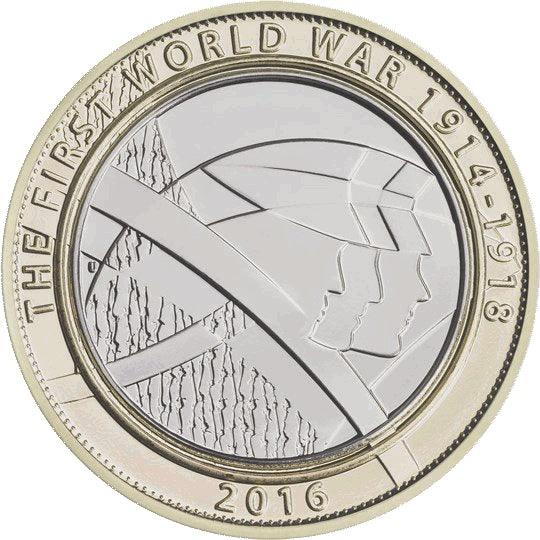The 2016 First World War Army £2 coin holds historical significance and is part of a series issued by The Royal Mint to commemorate the First World War.
This coin is the third in a series of £2 coins introduced by the Royal Mint in 2014, each commemorating different aspects of the First World War.
The entire range includes 2014 FWW Outbreak coin, 2015 FWW Navy coin, 2016 FWW Army coin, 2017 FWW Aviators (not in circulation) and the 2018 Armistice Two Pound coin (not in circulation).
History of the coin
After the outbreak of war in 1914, the British Army realized its size was insufficient to sustain the conflict. The concept of “Pals Battalions” emerged, where friends, neighbours, and colleagues enlisted together, forming close-knit units.
This coin pays tribute to their courage and sacrifice during a pivotal moment in military history.
Design of the coin
The reverse design, created by artist Tim Sharp, honours the “Pals Battalions”—groups of friends who enlisted together during the war.
The image depicts three pals marching side by side, shoulder to shoulder, facing to the right. Their silhouettes are powerful symbols of camaraderie and sacrifice.
The letter “u” on the far left represents the signature of the agency known as Uniform, with Tim Sharp being the creative director for the Uniform agency.

The outer rim bears the inscription: “THE FIRST WORLD WAR 1914-1918,” with the centred date “2016.”
The milled edge reads: “FOR KING AND COUNTRY.”
About the designer
Tim Sharp, a talented graphic designer, has made significant contributions to the world of numismatics through his work with The Royal Mint. His original design features on this magnificent coin, commemorating the British Army and pays tribute to the spirit of camaraderie among soldiers during the First World War.
The reverse side depicts three pals marching side by side, symbolizing the unity and pride of the communities they volunteered to defend.
Tim’s work reflects the spirit of camaraderie, sacrifice, and historical significance associated with the First World War.
Tim Sharp’s artistic vision has left an indelible mark on the world of coinage, capturing moments of history and honouring those who served
The obverse of each coin shows the fifth portrait of Queen Elizabeth II, designed by Jody Clark. This is the first time the portrait has been used on £2 coins, having only been unveiled in 2015.

Surrounding her head all around the outer circle is her legendary ELIZABETH II D G REG F D 2 POUNDS which translates from Latin to mean Elizabeth the Second, by the Grace of God, Queen, Defender of the Faith.
Designed by Royal Mint engraver, Jody Clark, the fifth definitive UK coin portrait features a bust of Queen Elizabeth II wearing the King George IV State Royal Diamond Diadem Crown, which she wore for her Coronation in 1953. The initials JC, are just below the neckline of Her Majesty Queen Elizabeth II.
Jody Clark chose this to link his design to the past as it was featured in the designs by both Raphael Maklouf and Arnold Machin. The Queen is also wearing the Diamond Jubilee drop pearl earring 's and her chin is lifted slightly.
Mintage of the Coin
The Royal Mint confirmed 2016 First World War Army £2 coin has a mintage of 9,550,000 coins, making it relatively common compared to most other £2 coins. It is estimated that over 7 million are still in circulation today.
Apart from the circulated version, there were other versions issued for collectors:
Brilliant Uncirculated: Mintage of 41,852
Proof First Day Cover: Mintage of 13,489
Silver Proof First Day Cover: Mintage of 2,744
Silver Proof Piedfort: Mintage of 1,387
Gold Proof: Mintage of 354
There were a number of other £2 coin released into circulation in 2016 namely the 2016 Shakespeare Comedies £2 Coin which had a mintage of 4,355,000, the 2016 Shakespeare Tragedies £2 Coin which had a mintage of 4,615,000 and the Histories £2 coin, slightly more at 5,655,000.
The 2016 Great Fire of London £2 Coin was also released in 2016 which had a low mintage of 1,625,000.
How rare is the 2016 First World War Army £2 Coin?
In terms of rarity, the PALS Battalion £2 is not considered rare due to its high mintage of only 9.5 million.
You are still able to find one in your change, despite the 2016 FWW £2 coin being in circulation for over 8 years now. However, coin collectors are adding them to their collection thus taking them out of circulation, and these coins will become harder and harder to find. If you do happen to find one, it is definitely worth hanging on to.
How much is the 2016 First World War Army Two Pound coin worth?
The 2016 First World War Army £2 coin is worth around £4.50 in good condition, which is considerably more than face value and the value of this coin is steadily increasing.
Where can I buy the 2016 First World War Army £2 Coin?
You can buy the 2016 First World War Army £2 coin online on auction sites such as eBay or Amazon but please ensure you look at all the information and reputation of the seller.
Alternatively, you can buy it from us by clicking here.
Unfortunately, as this coin is now 8 years old, the Royal Mint no longer stocks this coin so it is only available to buy on the secondary market.
Are there any known errors of this coin?
No errors have been confirmed by the Royal Mint for this coin.
Bit of trivia...
Pals battalions were a uniquely British phenomenon. Britain was the only major power not to begin the First World War with a mass conscripted army. After the war broke out, it quickly became clear that the small professional British Army was not large enough for a global conflict.
In a wave of patriotic fervour, thousands of men volunteered for service in Lord Kitchener's New Armies. As part of this, it was realised that local ties could be harnessed for national gain. Many more men would enlist if they could serve alongside their friends, relatives and workmates.
On 21 August 1914, the first Pals battalion began to be raised from the stockbrokers of the City of London. In a matter of days 1,600 men had joined what became the 10th Battalion, Royal Fusiliers. Lord Derby first coined the phrase 'battalion of pals' and recruited enough men to form three battalions of the King's (Liverpool) Regiment in only a week.
Pals battalions became synonymous with the towns of northern Britain. Men from cities including Manchester, Leeds, Newcastle, Hull, Glasgow and Edinburgh all enlisted in their thousands in 1914 and 1915. But Pals battalions were also raised from Birmingham to Bristol and from Cambridge to Cardiff.
After training, the first Pals battalions began to arrive on the Western Front from mid-1915. However, many of the Pals battalions were not to see their first major action until the first day of the Battle of the Somme on 1 July 1916. Many of these units sustained heavy casualties, which had a significant impact on their communities. With the introduction of conscription in 1916, the close-knit nature of the Pals battalions was never to be replicated.


3 comments
Caroline Fox
Have a £2 2016 WW1 coin that id like to sell. Its in very good condition. Whats the maximum price I could get for it?
Lee Bromley
thankyou for accepting comment as if it helps me gret this coin to a collector it feels better to get it to the hands of one!… I also have king george 1924 large half penny & 1966 small half penny and 1984 liberty one cent coin with Abe on it
Lee Bromley
I have the 2016 ww1 Pals Battalion £2 coin and wish to sell would you? or anyone else? be interested to buy off me today the 21st august 2024 if so i will put it in post to you’s today just get on the phone my telephone N0=07884900634
or email me on bromleylee87@gmail.com